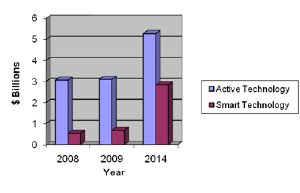Mar 23 2010
Nanotechnology, the science of very small materials, is poised to have a big impact in pharmaceutical packaging and will enable it to bring innovative and new generation packaging solutions to market.
 SHARE of global market for Nano-enabled Packaging FOR PHARMA BY TECHNOLOGY, 2008, 2009 and 2014 ($ billions)
SHARE of global market for Nano-enabled Packaging FOR PHARMA BY TECHNOLOGY, 2008, 2009 and 2014 ($ billions)
Packaging in the pharmaceutical industry has gone through major changes in the past decade. The advent of new drug delivery systems and the development of new biochemical compounds have resulted in a need not only for enhanced protection against factors such as moisture, light, oxygen and mechanical forces, but also for packaging forms to play a more integral role in the drug delivery process. Packaging design today provides stability and shelf life to the drug and the delivery system, which becomes fundamental to the safety, convenience and compliance of drug use.
Basic categories of nanotechnology applications and functionalities appear in development of pharmaceutical (or pharma) packaging in terms of enhancement of plastic materials’ barriers; incorporation of active components that can deliver functional attributes beyond those of conventional active packaging; and sensing and signaling of relevant information.
According to a recently published report from iRAP, Inc., PH-101 Nano-Enabled Packaging for the Pharmacetical Industry – A Global Technology, Industry and Market Analysis, the total market for nano-enabled packaging for pharma is $3.8 billion in 2009, which is expected to grow to $8.1 billion by 2014, at a compound annual growth rate (CAGR) of 16.5% from 2009 to 2014.
Pharmaceutical blister packaging will exhibit favorable growth in global demand based on adaptability to unit dose, clinical trial, compliance, institutional and over-the-counter drugs. Advances in the changeover features of processing machinery will also benefit growth by making blister packaging more cost-efficient in small volume drug applications. The global market for nano-enabled packaging for blisters was $941 million in 2008 and is expected to grow to $2.10 billion by 2014.
Global demand for pre-fillable inhalers and pre-fillable syringes will generate the fastest growth opportunities among all pharmaceutical packaging products, based on performance advantages in drug delivery and the introduction of new bioengineered medicines. Plastic bottles will sustain the largest share of global demand, based on low cost, versatility, availability, and ongoing quality and design improvements.
Global market growth for pharmaceutical closures and accessories will be led by child resistant, senior friendly, and dispensing closures; compliance-enhanced prescription containers; high visibility labels; and tamper-evident and anti-counterfeit accessories. Demand for these products will benefit from stricter government and industry standards covering the safety, security and ease of use features of drug containers.
The U.S. and Europe will remain the largest consumers of pharmaceutical packaging, as their advanced drug-producing sectors introduce new therapies with specialized packaging needs. Japan continues to have the major share of the Asia Pacific market (65%), but its share is expected to decrease as India evolves into a fast-growing pharmaceutical packaging market as drug-producing sectors are upgraded and diversified, especially in the area of generic drugs.
China’s growth opportunities will be among the strongest, based on rapidly expanding pharmaceutical manufacturing capabilities there and the phasing-in of a government program designed to upgrade the quality and integrity of nationally produced medicines.